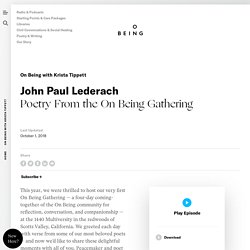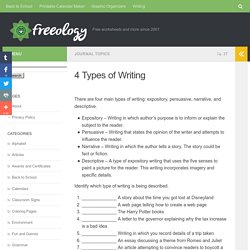

‘Watch-Think-Write’ and Other Proven Strategies for Using Video in the Classroom. One of the first things I added to my teacher tool kit during my first few years of teaching was video.

As a science middle school teacher, I saw using documentaries as an effective strategy. After all, the interviewees and talking heads presented in videos are experts in their field, often working with cutting-edge tools that I could only dream of using. Empower Every Voice. The Cult of Pedagogy Podcast.
Online voice recorder. But Why: A Podcast For Curious Kids Podcast. Paper Tear Communication. Sign In. Julian Treasure: 5 ways to listen better. 50 Strategies - Mini Lessons.pdf. National Writing Project. "Poetry writing in the classroom requires not rules but tools." @nickripatrazone speaks to poet and teacher @Kerrin_McCadden. Poetry From the Gathering — John Paul Lederach. Krista Tippett, host: Poetry reading framed the On Being Gathering this year.

And we are so happy now to share these slices of beauty, elation, and contemplation with you. Here’s how peacemaker and poet, John Paul Lederach, opened our Monday morning. [applause] John Paul Lederach: Thank you. I had no idea what Krista had in mind when she said, “Haiku, Monday morning.” 4 Types of Writing - Freeology. There are four main types of writing: expository, persuasive, narrative, and descriptive.

Expository – Writing in which author’s purpose is to inform or explain the subject to the reader.Persuasive – Writing that states the opinion of the writer and attempts to influence the reader.Narrative – Writing in which the author tells a story. The story could be fact or fiction.Descriptive – A type of expository writing that uses the five senses to paint a picture for the reader. This writing incorporates imagery and specific details. Identify which type of writing is being described. 6 Traits of Writing - Using the Model in the Classroom. The six traits of writing model provides a recipe for successful prose writing.

This approach defines the ingredients of effective writing for students to practice and teachers to assess, equipping both parties with tools for strategically analyzing written work. Students can become self-sufficient and methodical writers when they learn to develop the following characteristics in their writing. To take advantage of this revolutionary model, learn what the six traits are and how to teach them. What are the Six Traits of Writing? The six key characteristics that define high-quality writing are: IdeasOrganizationVoiceWord ChoiceSentence FluencyConventions Please note that while this method is often called the 6 + 1 Trait Model, the plus one "presentation" trait is largely optional as it is a characteristic of the overall product and not the writing itself.
Ideas This writing component captures the main idea of a piece through detail. The 5-Step Writing Process: From Brainstorming to Publishing. Every writer follows his or her own writing process. Often the process is a routine that comes naturally and is not a step-by-step guide to which writers refer. Being conscious of your own writing process is especially helpful when you find yourself struggling with a particularly tricky piece. Here are five steps towards creating or identifying your personal writing process. Brandon Sanders and Mikeala Miller. Writing Lesson: Expanding Sentences. If you're like me, you've read your share of rough drafts that were vague and difficult to follow.

Student-authors often forget that the reader was not present when the event took place, and the author fails to develop important details that will help the reader visualize the scene. Over the years, I have come to realize that most students will benefit from receiving explicit instruction on how to expand dull, short sentences in a way that will help the reader picture the event they are describing. Today, I am going to outline a minilesson that focuses on expanding sentences. #1- Outline the problem. We stood outside for twenty minutes. After writing that sentence on the board, ask students to judge whether it's a strong sentence or a weak sentence. The Mother With One Eye Musical Chairs Activity- Four Resource Model. Learning Games and Apps for Kids. Edpuzzle.
The Importance of Reading Aloud to Big Kids. Only 17% of parents of kids ages 9–11 read aloud to their children.

Yet 83% of kids ages 6–17 say being read to is something they either loved or liked a lot. (Scholastic’s “Kids & Family Reading ReportTM”) Why we should all be reading aloud to children. Anticipation guide Template from Think Literacy. PT Blooms w activities WR. Do Ink. Do Ink Tips in Two.mov. The Newspaper Clipping Generator - Create your own fun newspaper.
Break Your Own News - Breaking News Generator. Plickers. Make Learning Awesome! The Jigsaw Method. Join a presentation - Mentimeter. Critical Thinking Skills 1. WrightFamily. QR Code Generator. Digital Escape Rooms in your Classroom - Classtime. If you’re not familiar with the “Escape Room” (and increasingly digital escape rooms) phenomenon found across the U.S., you’re definitely missing out!

Escape rooms have made their way into recreational entertainment, board games, and even Hollywood. The premise is relatively simple: players must complete a series of tasks in order to gain passwords, retrieve clues, or gather other information needed to “escape the room”– digitally, physically, or both. The idea is extremely innovative: it works with any content area, particular skill, or objective you’re teaching, and students are needless to say, extremely into it. I Wish My Teacher Knew Worksheets & Teaching Resources.
Common Ground / Uncommon Commonalities. Materials: None How To Play-Common Ground: Players circle up and form partners or small groups.

Partners or groups discover commonalities among them by taking turns asking each other questions e.g. Here's How to Write a Blog Post Like a Professional. You sit down.

You stare at your screen.